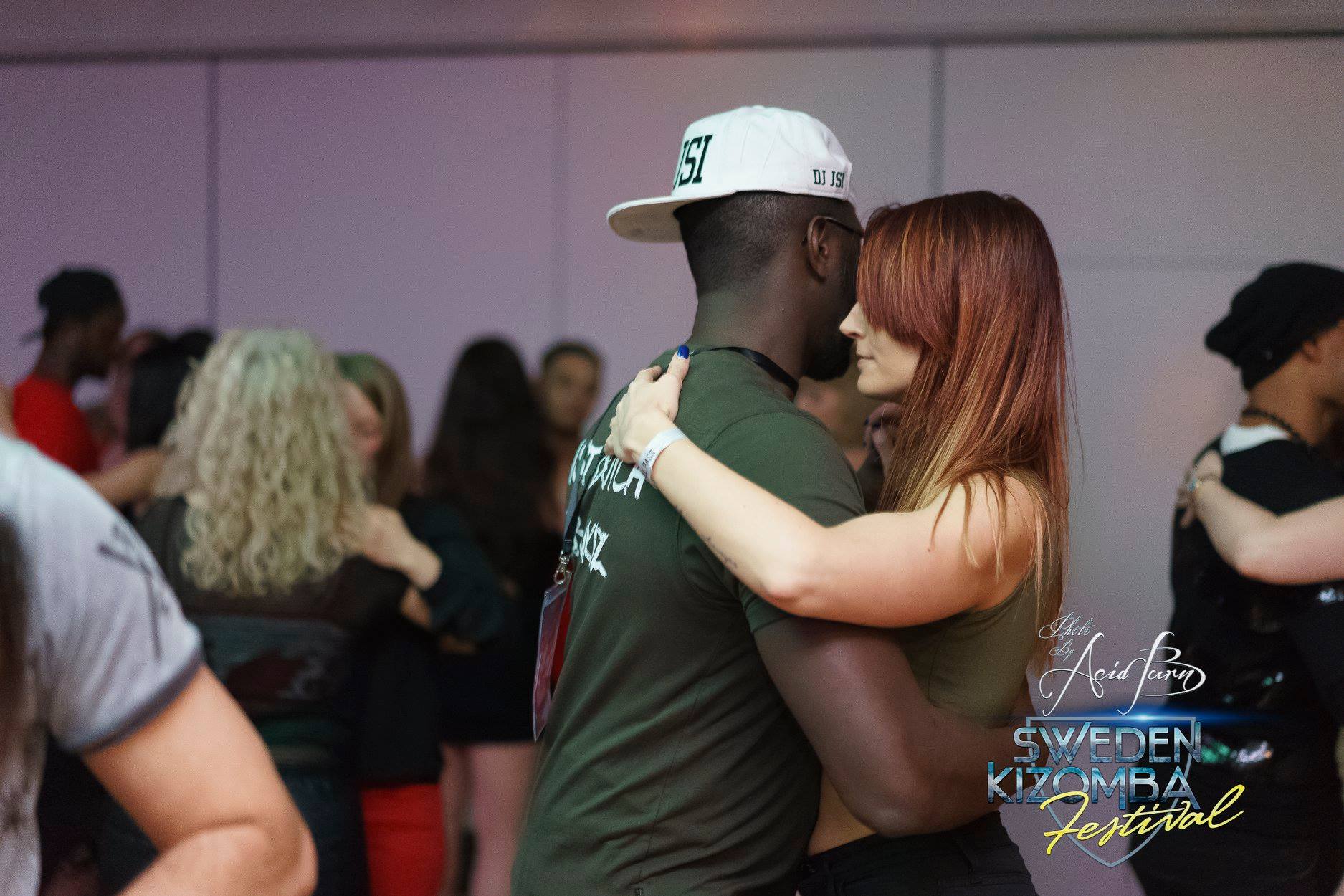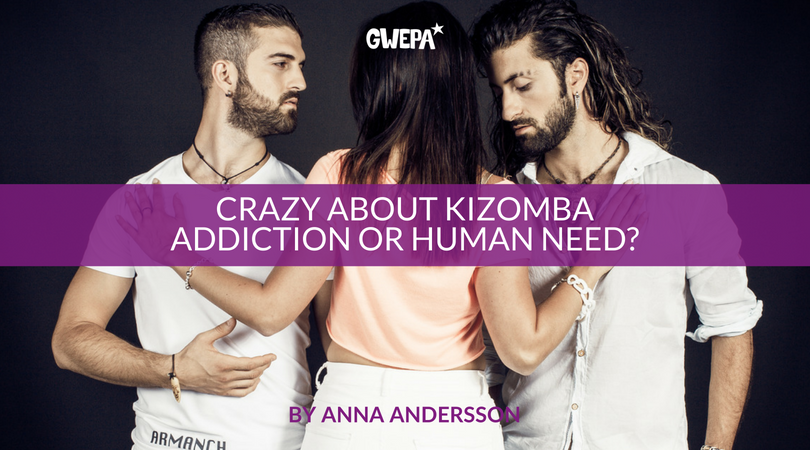We carry around dance shoes in our bags just in case. We choose kizomba before clubbing, alcohol, and sometimes even (non-dance) friends. We cannot think of anything that gives us the same kick and rewarding feeling than getting lost on the dance floor. Finding the perfect partner. Experiencing connection. And to shut out the world for a while. So, does this mean we are addicted to kizomba?
Addiction is usually connected to negativity, it refers to something we crave for and need so badly, with damaging consequences. Psychology today (1) defines addiction as: “a condition in which a person engages in use of a substance or in a behavior for which the rewarding effects provide a compelling incentive to repeatedly pursue the behavior despite detrimental consequences.”

Photo: Micke Widén
No doubt kizomba is rewarding, just think about the enormous oxytocin level that we get compared to the rest of the world. As you probably know, when we hug someone, the “cuddle hormone” oxytocin (5) is released, creating that warm and fuzzy feeling inside (2), making us all calm and relaxed. By releasing these cannabis-like molecules, it facilitates social bonding and acts as a buffer against stress, anxiety and depression. No wonder we often describe dancing as being high without taking drugs.
But is too much dancing harmful? On my blog (3) I have previously written about the importance of nurturing relationships and activities outside the dance scene, to remember our “other rooms” in order to maintain a balance. As in seeing family, friends, doing sports, consuming culture, knitting or whatever you like doing.

Photo: Acbfoto.eu
Dancing, and especially (urban) kizomba in my case, can certainly create a need to chase more, and make it a priority over everything. We can dance for ten hours straight without eating, and as the DJ plays the last song we feel dissatisfaction and start chasing the after party so that we can continue dancing till 11 AM, at least. We go from the last song to the hotel breakfast like zombies. All happy, just so crazily tired that we can’t even talk properly, but laughing and dancing between the coffee machine and scrambled eggs. And god knows how our sore feet and bodies can handle it, it’s like we switch to a kiz autopilot, or become some sort of superhumans. Nevertheless, the reward is worth all lack of sleep and sore bodies – a fulfilling sensation, a kick that’s better than eating and sleeping.
But this craziness of wrecking ourselves with no sleep, emptying our saving accounts to be able to constantly travel to wherever the action is. The desire to book another festival before we even returned from one. And the fact that we are ready to ditch other plans just to get some quality dance. What kind of behaviour is that?

I’ve spent a lot of time thinking about why and how kizomba is so special that it becomes such a craving. How many times have you as a dancer found yourself at a ‘normal’ party or nightclub thinking I wish I was dancing instead. Or even, WHAT IF there’s a kizomba person here in the club, then we could dance kizomba to hip hop music! And we almost wish it said kizomba on people’s foreheads, so we knew. So we would never miss a chance to dance. A great example of this dancers’ restlessness is Stranded Kizomba, a Facebook group where you simply announce your presence at any airport to find a dance partner, usually after a festival when the well known post-festival-depression kicks in. The activity in this group is high with a constant flow of successful airport dances posted. We dancers understand. Others might not.
But what do kizomba and other social dances give us that alcohol and social hangouts don’t? Well, obviously the fantastic feeling of connection, to move your body as one with your partner. To express yourself to the music you love. And all that. But I truly believe this addiction or need is connected to one more thing that is rare today, which is uniqueness. For a limited time, you are exclusive. 20 minutes, an hour, or however long the dance lasts, you are for once present with another human being. Without phones between you, without interruption, even without verbal communication.

You are sharing body language, musicality, connection and even breathing. It’s a vacuum of presence, where sensibility and sensuality take you to other dimensions. In the arms of your partner you feel safe, you feel seen, and you automatically forget about the world outside. It’s two individuals connecting, feeling, moving, breathing together. A carpenter and a teacher. An engineer and an art student. A French and a Danish. An American and a Swedish. A 25 year old and a 45 year old. These are things you might not even know, and they don’t matter. The only thing that matters is you two, and that you give each other your full attention for a moment.

Photo: Saturday’s Kizomba
When did you get someone’s full attention last time? Imaging the world we live in today. Friends eating out, and phones are automatically placed on the dinner table, selfies need to be taken, places need to be tagged, filters need to be added, emotions need to be expressed – digitally. At a doctor’s appointment, a time when we are vulnerable and still don’t get the attention we need most of the time, because the doctor doesn’t have the time to listen. The supermarket where the check-out staff does their thing and you two meet as strangers with a cold “hi”. On the way to work – music and podcasts in ears, escaping to other worlds, passing by people, without meeting them. Shutting out the world. A mix of distraction and multitasking that we got so used to.

So, is this obsession of dancing an addiction or simply a human need? I remember talking about this topic with Charles Ogar, who always has interesting thoughts on the aspects of cultural expressions in the scene (Charles we never finished the talk, let me know your view). I think kizomba is a rewarding crave, that I also know can harm, as much as it can enrich, social life and self confidence for example. And I strongly believe that quitting will cause some serious abstinence, hence you can see it as an addition. However to be close, to be seen, to feel safe in someone’s arms, to feel touch – that’s more connected to human need. And the unique experience to get that quiet space of attention.
List of sources:
- https://www.psychologytoday.com/us/basics/addiction
- https://www.huffingtonpost.com/2014/03/27/health-benefits-of-huggin_n_5008616.html
- www.Annathefringe.com
- https://www.facebook.com/groups/611573362376498/
- https://www.psychologytoday.com/us/articles/201703/tend-and-defend
ANNA ANDERSSON
Guest Blogger

Anna is a Swedish social media professional, writer and dancer, based in Amsterdam. She has a strong passion for urban kizomba, traveling, telling stories and challenging convention. On her personal blog she highlights the joyful as well as darker sides of dancing, alternative relationship models and life choices. She has been teaching urban kizomba in Gothenburg and Amsterdam and describes herself as a sensual dancer, always chasing magical connections.
Blog:
http://annathefringe.com/
Facebook page:
https://www.facebook.com/annathefringekiz/


